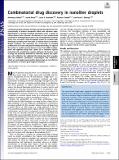| dc.contributor.author | Kulesa, Anthony Benjamin | |
| dc.contributor.author | Kehe, Jared Scott | |
| dc.contributor.author | Hurtado, Juan E. | |
| dc.contributor.author | Tawde, Prianca K. | |
| dc.contributor.author | Blainey, Paul C | |
| dc.date.accessioned | 2019-02-08T16:38:01Z | |
| dc.date.available | 2019-02-08T16:38:01Z | |
| dc.date.issued | 2018-06 | |
| dc.date.submitted | 2018-02 | |
| dc.identifier.issn | 0027-8424 | |
| dc.identifier.issn | 1091-6490 | |
| dc.identifier.uri | http://hdl.handle.net/1721.1/120291 | |
| dc.description.abstract | Combinatorial drug treatment strategies perturb biological networks synergistically to achieve therapeutic effects and represent major opportunities to develop advanced treatments across a variety of human disease areas. However, the discovery of new combinatorial treatments is challenged by the sheer scale of combinatorial chemical space. Here, we report a high-throughput system for nanoliter-scale phenotypic screening that formulates a chemical library in nanoliter droplet emulsions and automates the construction of chemical combinations en masse using parallel droplet processing. We applied this system to predict synergy between more than 4,000 investigational and approved drugs and a panel of 10 antibiotics against Escherichia coli, a model gram-negative pathogen. We found a range of drugs not previously indicated for infectious disease that synergize with antibiotics. Our validated hits include drugs that synergize with the antibiotics vancomycin, erythromycin, and novobiocin, which are used against gram-positive bacteria but are not effective by themselves to resolve gram-negative infections. Keywords: high-throughput screening; nanoliter droplet; drug synergy; antibiotics; small molecules | en_US |
| dc.publisher | National Academy of Sciences (U.S.) | en_US |
| dc.relation.isversionof | http://dx.doi.org/10.1073/PNAS.1802233115 | en_US |
| dc.rights | Article is made available in accordance with the publisher's policy and may be subject to US copyright law. Please refer to the publisher's site for terms of use. | en_US |
| dc.source | PNAS | en_US |
| dc.title | Combinatorial drug discovery in nanoliter droplets | en_US |
| dc.type | Article | en_US |
| dc.identifier.citation | Kulesa, Anthony et al. “Combinatorial Drug Discovery in Nanoliter Droplets.” Proceedings of the National Academy of Sciences 115, 26 (June 2018): 6685–6690 © 2018 National Academy of Sciences | en_US |
| dc.contributor.department | Massachusetts Institute of Technology. Department of Biological Engineering | en_US |
| dc.contributor.department | Massachusetts Institute of Technology. Department of Mechanical Engineering | en_US |
| dc.contributor.mitauthor | Kulesa, Anthony Benjamin | |
| dc.contributor.mitauthor | Kehe, Jared Scott | |
| dc.contributor.mitauthor | Hurtado, Juan E. | |
| dc.contributor.mitauthor | Tawde, Prianca K. | |
| dc.contributor.mitauthor | Blainey, Paul C | |
| dc.relation.journal | Proceedings of the National Academy of Sciences | en_US |
| dc.eprint.version | Final published version | en_US |
| dc.type.uri | http://purl.org/eprint/type/JournalArticle | en_US |
| eprint.status | http://purl.org/eprint/status/PeerReviewed | en_US |
| dc.date.updated | 2019-02-08T14:54:06Z | |
| dspace.orderedauthors | Kulesa, Anthony; Kehe, Jared; Hurtado, Juan E.; Tawde, Prianca; Blainey, Paul C. | en_US |
| dspace.embargo.terms | N | en_US |
| dc.identifier.orcid | https://orcid.org/0000-0001-9927-9715 | |
| dc.identifier.orcid | https://orcid.org/0000-0002-1028-5981 | |
| dc.identifier.orcid | https://orcid.org/0000-0001-7014-3830 | |
| mit.license | PUBLISHER_POLICY | en_US |
